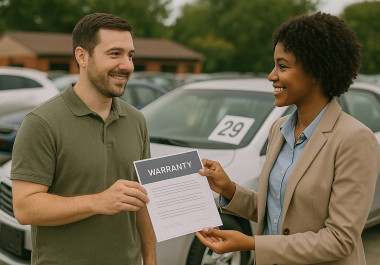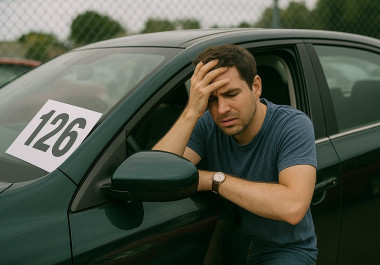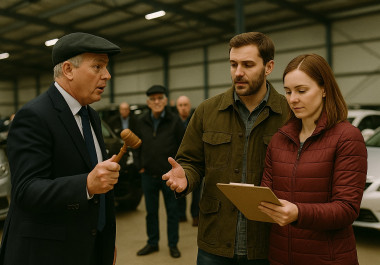There’s a certain feeling that seeing a proper E-Type Jaguar or an old Austin-Healey sparks. It’s a little flutter in the chest, a sense of looking at more than just a machine. It’s a piece of history, a bit of art on wheels. For those who have spent decades in the motor trade, that feeling never gets old. The real excitement, however, the true buzz? That's found at a classic car auction.
The atmosphere at these events is simply electric. It is a real mix of hope, nostalgia, and sharp-eyed folks all looking for a hidden gem. But the truth is, for every person who drives home with their dream motor, another has just bought a lorry-load of trouble. The intense energy of an auction can lead to hasty decisions. That’s why it’s vital to go in with a clear head and some solid know-how. Knowing what to look for is what separates a smart buy from a costly mistake.
What’s the Big Deal with Classic Cars?
So, why does anyone get so sentimental about these old motors? First off, it’s their timeless design. These cars were drawn with passion, not put together by a committee with a spreadsheet. For many, they bring back fond memories of a first car, or the one their dad used to polish every Sunday. Each one has a story, a soul. It's clear that owning a classic car isn't just about possession; it's about becoming a custodian. It's about keeping a piece of motoring history on the road for the next generation to enjoy.
And here’s the kicker. It can be a shrewd investment. Unlike a new car that loses a chunk of its value the second it drives off the forecourt, a well-bought classic can actually go up in value. It’s a fantastic hobby that doesn’t have to cost the earth. Moreover, the community around vintage cars in the UK is second to none. It’s full of friendly, down-to-earth people, all united by a love for oil, leather, and chrome.
Why Auctions are the Place to Be
Try finding a row of Triumph TR6s at a local dealership. It simply won't happen. Dealerships just don’t stock them anymore. For this reason, everyone from serious collectors with deep pockets to first-time buyers with a dream ends up at an auction. It’s an open and honest place where the car is the star of the show. While expertise isn't required to place a bid, a bit of homework beforehand pays for itself ten times over.
Some auctions are purely for classics, which is a real treat for any enthusiast. Others mix them in with the regular, everyday runners. Either way, the thrill of the auction room has made these events a key destination for car fans. It doesn’t matter if you are there in overalls or bidding online in pyjamas. Ultimately, it’s the single best way to see a wide range of vehicles in one place.
Finding the Right Classic Car Auction for You
So, where does the great hunt begin? In the old days, the search involved flicking through specialist magazines or getting a tip from a pal at the local car club. These days, a lot of the action has moved online. A cracking first stop is to explore the vehicle auctions at Raw2K. Their site covers all sorts, so it’s possible to see everything from modern salvage cars to proper old-timers.
The best advice is not to just look down the road. Some of the best finds over the years have been a few hours' drive away. It pays to be prepared to travel for the right car.
-
Regional Auctions: These are found all over the country, from Scotland down to the south coast. Keep an eye on local listings as you never know what might turn up.
-
Specialist Online Platforms: Some websites deal only in vintage motors. These can be great for finding specific or rare models, though prices can sometimes be higher.
-
Motoring Festivals: Big events like the Goodwood Revival often have a top-notch auction. These are fantastic to visit, even if it’s just to soak it all in and dream a little.
Getting Yourself Prepared for Auction Day
This bit is crucial. Walking into a hall filled with beautiful old cars is a powerful experience. It’s incredibly easy to let the heart rule the head and get swept up in what’s known as "auction fever." A little bit of planning is what stops a buyer from waking up the next morning with a huge hole in their bank account and a car they can’t afford to fix. Therefore, a firm budget must be set before a single bid is placed, and it absolutely has to be respected. No exceptions.
Remember that "classic" covers a wide range. It could be a perfect, show-winning motor or a rusty project that needs a mountain of work. Both are great finds for the right person, but they come with very different price tags and workloads. It’s vital to be honest about what you’re looking for.
The Value of an Expert Opinion
It’s a common story. A young buyer, keen as mustard, falls head over heels for a shiny red MG Midget. It looks perfect on the outside, but they don’t know the first thing about what’s lurking underneath. For anyone new to this game, the best money ever spent is on bringing a friend or a trusted mechanic along. Their second opinion is invaluable.
Consider this real-life example. A few years back, a fellow in a sharp suit was dead set on buying a beautiful-looking Jensen Interceptor. He’d seen it online and was ready to pay top dollar. At the viewing, to the untrained eye, it was flawless. But a closer look revealed the faintest bubbles under the paint on the rear arches and a slight sag in the driver’s door. These are classic signs of hidden rust and a tired chassis. A quiet word from an experienced observer was all it took. The buyer ended up passing on it and later found a much better, more honest car for his money. That second pair of eyes saved him thousands.
It’s like getting a survey on a house. Think about it. Would anyone buy a house without a surveyor checking the foundations? Of course not. An expert look at a classic car follows the exact same principle. The shiny paint is the fancy new kitchen that catches the eye, but someone needs to check the important bits. These include the chassis, the engine, the electrics, and that all-important logbook. It’s the only way to know if you’re buying a dream or a money pit.
Understanding What You’re Bidding On
Auctions feature everything from our motorcycle auctions to our dedicated van auctions. While the bidding process works the same, what to look for in a classic is completely different.
-
Bidding Intensity: Expect fierce competition for truly iconic models. If a Series 1 Land Rover or an original Mini Cooper comes up, be prepared for a fight. Researching what they typically sell for is essential to avoid overpaying.
-
Original vs. Restored: The auction catalogue will talk about original parts versus restored ones. An original part, even with a bit of wear, can be more valuable to purists than a brand-new reproduction because it tells a story.
-
"Matching Numbers": This term comes up a lot. It simply means the engine, chassis, and gearbox numbers all match the original factory records. For serious collectors, this is a very big deal and adds a lot to the car's value.
A Few Words You’ll Hear (And What They Really Mean)
When starting out, some of the lingo can be confusing. Here’s a translation of some common terms.
-
Provenance: This is just a fancy word for the car's history. Good provenance means a thick folder of documents, service history, and proof of previous owners. Bad provenance means a single, crumpled V5C and a seller who avoids eye contact.
-
Barn Find: This describes a classic that has been discovered after being stored away, often for decades. They usually need a complete restoration but can be incredibly exciting finds. In short, it's the car equivalent of a lottery ticket.
-
Restomod: This is a classic car that has been restored but also modified with modern parts. For instance, it might have new brakes, suspension, or even an engine. They can be brilliant to drive but are often less valuable to purists who want originality.
Making Sense of Condition Ratings
Most auction houses provide a rating to give a rough idea of the car's state. It’s vital to be brutally honest about personal skills and budget.
-
Concourse Level: This is the top of the tree. It describes a car in near-perfect condition, often better than when it left the factory. These are "trailer queens," rarely driven and fit for the poshest of car shows.
-
Restored Driver: This is the sweet spot for most people. It's a car that looks fantastic and runs well. It’s perfect for weekend drives and local shows, but not so perfect that the fear of a stone chip ruins the experience.
-
Project in Waiting: Now, tread carefully here. This one needs some love. It could be a simple weekend project or a full nut-and-bolt restoration. These can be brilliant, but they can also be money pits that'll break a heart and a bank account.
The Paperwork is Non-Negotiable
This point cannot be stressed enough. It doesn’t matter if it’s the most beautiful car in the world; if the paperwork isn’t right, walk away. A car without a history is a car with a secret, and no buyer wants to be the one to find out what it is.
Three things are absolutely essential to see:
-
V5C (Logbook): This is the official document proving who the keeper is. Check that the Vehicle Identification Number (VIN) on the document matches the one on the car's chassis plate. No excuses.
-
MOT Certificate: Unless the car is old enough to be exempt, it needs proof of a valid MOT. Always double-check the latest government rules on this.
-
Service Records: A thick folder stuffed with old receipts and service stamps is a very, very good sign. It shows the car has been loved and cared for, not just patched up for a quick sale.
If a seller is vague about the documents, treat it as a massive red flag. Updates on DVLA rules can usually be found in our News section.
After the Hammer Falls: You’ve Won! Now What?
There’s no feeling quite like it. The auctioneer points, the hammer comes down, and the car is yours. It's a brilliant moment! But don’t get carried away with celebrations just yet, as the job isn’t finished.
Here’s what happens next:
-
Payment: A deposit is required immediately, with the balance due very soon after. Most people use a bank transfer for this.
-
Paperwork: Head to the office to sign the forms and officially transfer ownership. This is when the all-important V5C is handed over.
-
Transport: If the car is road-legal and insured, it can be driven home. If not, a trailer will need to be arranged.
-
Post-Purchase Check: Even if it looks perfect, book it in with a trusted specialist for a thorough check-up. This step provides crucial peace of mind.
Starting Your Classic Car Adventure
For anyone keen to get started in the world of classic car auctions, the best advice is simple: leave the wallet at home for the first few visits. Just go and watch. See which cars get the most attention, listen to what people are saying, and watch what things sell for. This is a brilliant way to learn the ropes without any risk.
The community is truly the best part of this world. Go to a local car meet and have a chat with the owners. You’ll find people who are more than happy to share what they’ve learned. These events and our online car auctions are a gateway to a fantastic hobby.
Be patient, do the homework, and balance that excitement with a dose of common sense. Follow that advice, and you’ll find a car to love for years to come. When you're ready to bid, the steps on our Register page are very straightforward. If any questions come up, don't hesitate to get in touch with the team via the Contact Page.




